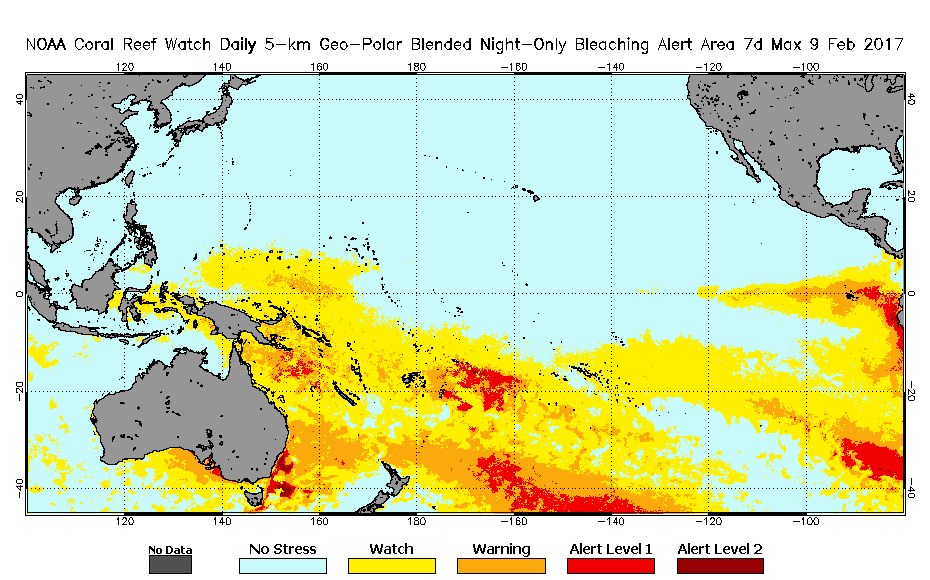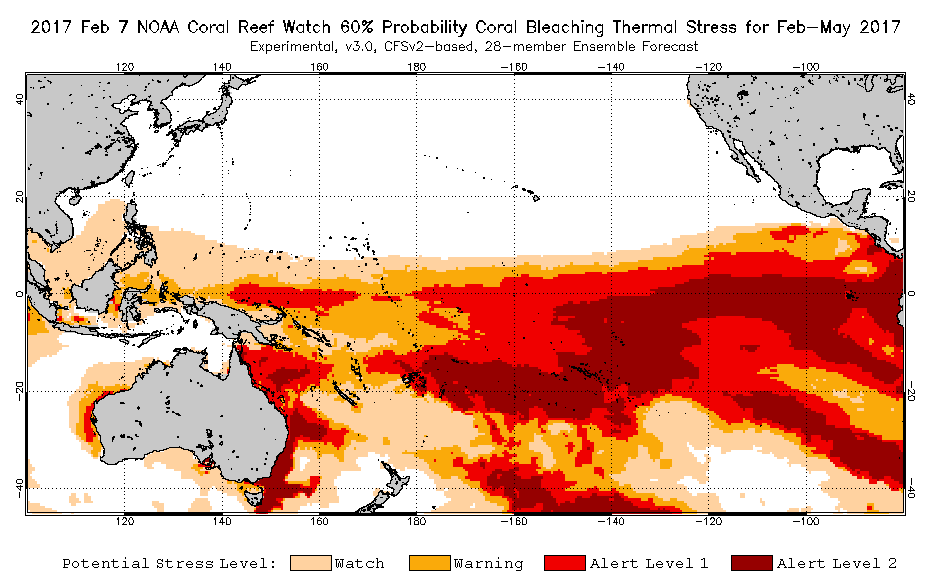Coral Bleaching Heat Stress Analysis and
Seasonal Guidance through May 2017
(Released February 10, 2017)
Current conditions:
NOAA Coral Reef Watch's (CRW) near-real-time satellite monitoring shows slightly below-average sea surface temperature (SST) anomalies across much of the central equatorial Pacific Ocean and slightly above-average SSTs in the eastern Pacific (Figure 1). NOAA's National Centers for Environmental Prediction has issued its final La Niña Advisory for Northern Hemisphere winter 2016-17. ENSO-neutral conditions have arrived and are expected to continue through Northern Hemisphere spring 2017.

|
||
|
Figure 1. NOAA Coral Reef Watch's Satellite Sea Surface Temperature (SST) Anomaly product for the Pacific region. |
||
HotSpots in the Northern Hemisphere remain concentrated around the Federated States of Micronesia (FSM) and the western Pacific (Figure 2), where a Bleaching Watch is in effect (Figure 3). Heat stress that can lead to coral bleaching has migrated into the Southern Hemisphere; Papua New Guinea, the Solomon Islands, Fiji (where water temperatures have spiked to over 34℃ in the shallow back reefs and bleaching is starting to intensify), and the Chesterfield Islands (in the Coral Sea to the south) are now at a level of Bleaching Warning. Vanuatu and New Caledonia are heating up as well but remain at a level of Bleaching Watch. The Far Northern Great Barrier Reef (GBR) has seen some mild to moderate accumulation of bleaching stress, as indicated by NOAA CRW's 5km Degree Heating Week product, and has reached Bleaching Warning status. The majority of the Southern Hemisphere heating has been concentrated around the Samoas and the Southern Cook Islands, which are both at Alert Level 1, along with Southern and Northern Tonga. Most of French Polynesia is in Bleaching Watch status, with the exception of the Austral Islands, which have reached Bleaching Warning status and are expected to escalate to Alert Level 2 conditions along with the rest of French Polynesia in the coming months.

|
||
|
Figure 2. NOAA Coral Reef Watch's Satellite Coral Bleaching HotSpot product for the Pacific region. |
||

|
||
|
Figure 3. NOAA Coral Reef Watch's Satellite Bleaching Alert Area (7-day maximum) product for the Pacific region. |
||
CRW's most recent Four-Month Coral Bleaching Heat Stress Outlook (Figure 4) projects heat stress to be highest from Fiji eastward to the Samoas and the Southern Cook Islands. As noted above, these areas are expected to reach Alert Level 2 bleaching conditions (associated with widespread coral bleaching and significant mortality) in the next 1-4 weeks. French Polynesia is expected to reach Alert Level 2 by mid-April 2017. The GBR is projected to reach Alert Level 1 by the end of February, with the possibility of Alert Level 2 conditions in the Northern and Far Northern GBR. By May 2017, the high level of bleaching heat stress is expected to migrate north, impacting the Marquesas Islands.

|
||
|
Figure 4. NOAA Coral Reef Watch's Four-Month Coral Bleaching Thermal Stress Outlook for February-May 2017 for the Pacific region. |
||
NOTE: This report focuses on NOAA Coral Reef Watch's new 5km satellite-based coral bleaching heat stress products and new v3.0 Four-Month Coral Bleaching Heat Stress Outlook. The 5km satellite products presented here use CRW's new color scales, which are already implemented in the images posted on the CRW website.
To monitor the intensity and location of bleaching heat stress in your coral reef region of interest, please follow NOAA Coral Reef Watch's satellite monitoring and outlooks closely in the coming weeks: https://coralreefwatch.noaa.gov/satellite/bleaching5km/index.php and https://coralreefwatch.noaa.gov/satellite/bleachingoutlook_cfs/outlook_cfs.php.
CRW's current satellite and modeled products can be found at:
https://coralreefwatch.noaa.gov/satellite/index.php
CRW's Four-Month Coral Bleaching Heat Stress Outlooks can be found at:
https://coralreefwatch.noaa.gov/satellite/bleachingoutlook_cfs/outlook_cfs.php
CRW's 5km satellite Regional Virtual Stations can be found at:
https://coralreefwatch.noaa.gov/vs/index.php
Sign up for automated bleaching alert emails for CRW's 5km Regional Virtual Stations at:
http://coralreefwatch-satops.noaa.gov/
CRW's 50km satellite Virtual Stations can be found at:
https://coralreefwatch.noaa.gov/satellite/vs.php
Please report bleaching events (or non-events) at:
http://www.reefbase.org/contribute/bleachingreport.aspx
Disclaimer
The content posted on this web page solely represents the opinions of the authors and does not constitute a statement of policy, decision, or position on behalf of NOAA or the US Government.
The appearance of external links on this World Wide Web site does not constitute endorsement by the Department of Commerce/National Oceanic and Atmospheric Administration of external Web sites or the information, products or services contained therein. For other than authorized activities, the Department of Commerce/NOAA does not exercise any editorial control over the information you may find at these locations. These links are provided consistent with the stated purpose of this Department of Commerce/NOAA Web site.